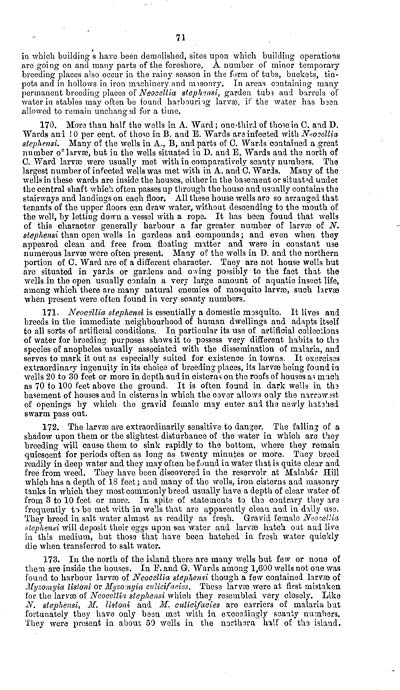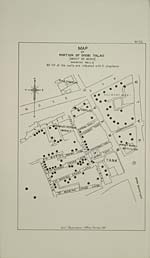Medicine - Disease > Report of an investigation into the causes of malaria in Bombay and the measures necessary for its control
(109) Page 71
Download files
Individual page:
Thumbnail gallery: Grid view | List view

71
in which building s have been demolished, sites upon which building operations
are going on and many parts of the foreshore. A number of minor temporary
breeding places also occur in the rainy season in the form of tubs, buckets, tin-
pots and in hollows in iron machinery and masonry. In areas containing many
permanent breeding places of Neocellia stephensi, garden tubs and barrels of
water in stables may often be found harbouring larv, if the water has been
allowed to remain unchanged for a time.
170. More than half the wells in A. Ward; one-third of those in C. and D.
Wards and 10 per cent. of those in B. and E. Wards are infected with Neocellia
stephensi. Many of the wells in A., B, and parts of C. Wards contained a great
number \ill\ larv, but in the wells situated in D. and E. Wards and the north of
C. Ward larv were usually met with in comparatively scanty numbers. The
largest number of infected wells was met with in A. and C. Wards. Many of the
wells in these wards are inside the houses, either in the basement or situated under
the central shaft which often passes up through the house and usually contains the
stairways and landings on each floor. All these house wells are so arranged that
tenants of the upper floors can draw water, without descending to the mouth of
the well, by letting down a vessel with a rope. It has been found that wells
of this character generally harbour a far greater number of larv of N.
stephensi than open wells in gardens and compounds; and even when they
appeared clean and free from floating matter and were in constant use
numerous larv were often present. Many of the wells in D. and the northern
portion of C. Ward are of a different character. They are not house wells but
are situated in yards or gardens and owing possibly to the fact that the
wells in the open usually contain a very large amount of aquatic insect life,
among which there are many natural enemies of mosquito larv, such larv
when present were often found in very scanty numbers.
171. Neocellia stephensi is essentially a domestic mosquito. It lives and
breeds in the immediate neighbourhood of human dwellings and adapts itself
to all sorts of artificial conditions. In particular its use of artificial collections
of water for breeding purposes shows it to possess very different habits to the
species of anopheles usually associated with the dissemination of malaria, and
serves to mark it out as especially suited for existence in towns. It exercises
extraordinary ingenuity in its choice of breeding places, its larv being found in
wells 20 to 30 feet or more in depth and in cisterns on the roofs of houses as much
as 70 to 100 feet above the ground. It is often found in dark wells in the
basement of houses and in cisterns in which the cover allows only the narrowest
of openings by which the gravid female may enter and the newly hatched
swarm pass out.
172. The larv are extraordinarily sensitive to danger. The falling of a
shadow upon them or the slightest disturbance of the water in which are they
breeding will cause them to sink rapidly to the bottom, where they remain
quiescent for periods often as long as twenty minutes or more. They breed
readily in deep water and they may often be found in water that is quite clear and
free from weed. They have been discovered in the reservoir at Malabr Hill
which has a depth of 18 feet; and many of the wells, iron cisterns and masonry
tanks in which they most commonly breed usually have a depth of clear water of
from 3 to 10 feet or more. In spite of statements to the contrary they are
frequently to be met with in wells that are apparently clean and in daily use.
They breed in salt water almost as readily as fresh. Gravid female Neocellia
stephensi will deposit their eggs upon sea water and larv hatch out and live
in this medium, but those that have been hatched in fresh water quickly
die when transferred to salt water.
173. In the north of the island there are many wells but few or none of
them are inside the houses. In F. and G. Wards among 1,600 wells not one was
found to harbour larv of Neocellia stephensi though a few contained larv of
Myzomyia listoni or Myzomyia culicifacies. These larv were at first mistaken
for the larv of Neocellia stephensi which they resembled very closely. Like
N. stephensi, M. listoni and M. culicifacies are carriers of malaria but
fortunately they have only been met with in exceedingly scanty numbers.
They were present in about 50 wells in the northern half of the island.
in which building s have been demolished, sites upon which building operations
are going on and many parts of the foreshore. A number of minor temporary
breeding places also occur in the rainy season in the form of tubs, buckets, tin-
pots and in hollows in iron machinery and masonry. In areas containing many
permanent breeding places of Neocellia stephensi, garden tubs and barrels of
water in stables may often be found harbouring larv, if the water has been
allowed to remain unchanged for a time.
170. More than half the wells in A. Ward; one-third of those in C. and D.
Wards and 10 per cent. of those in B. and E. Wards are infected with Neocellia
stephensi. Many of the wells in A., B, and parts of C. Wards contained a great
number \ill\ larv, but in the wells situated in D. and E. Wards and the north of
C. Ward larv were usually met with in comparatively scanty numbers. The
largest number of infected wells was met with in A. and C. Wards. Many of the
wells in these wards are inside the houses, either in the basement or situated under
the central shaft which often passes up through the house and usually contains the
stairways and landings on each floor. All these house wells are so arranged that
tenants of the upper floors can draw water, without descending to the mouth of
the well, by letting down a vessel with a rope. It has been found that wells
of this character generally harbour a far greater number of larv of N.
stephensi than open wells in gardens and compounds; and even when they
appeared clean and free from floating matter and were in constant use
numerous larv were often present. Many of the wells in D. and the northern
portion of C. Ward are of a different character. They are not house wells but
are situated in yards or gardens and owing possibly to the fact that the
wells in the open usually contain a very large amount of aquatic insect life,
among which there are many natural enemies of mosquito larv, such larv
when present were often found in very scanty numbers.
171. Neocellia stephensi is essentially a domestic mosquito. It lives and
breeds in the immediate neighbourhood of human dwellings and adapts itself
to all sorts of artificial conditions. In particular its use of artificial collections
of water for breeding purposes shows it to possess very different habits to the
species of anopheles usually associated with the dissemination of malaria, and
serves to mark it out as especially suited for existence in towns. It exercises
extraordinary ingenuity in its choice of breeding places, its larv being found in
wells 20 to 30 feet or more in depth and in cisterns on the roofs of houses as much
as 70 to 100 feet above the ground. It is often found in dark wells in the
basement of houses and in cisterns in which the cover allows only the narrowest
of openings by which the gravid female may enter and the newly hatched
swarm pass out.
172. The larv are extraordinarily sensitive to danger. The falling of a
shadow upon them or the slightest disturbance of the water in which are they
breeding will cause them to sink rapidly to the bottom, where they remain
quiescent for periods often as long as twenty minutes or more. They breed
readily in deep water and they may often be found in water that is quite clear and
free from weed. They have been discovered in the reservoir at Malabr Hill
which has a depth of 18 feet; and many of the wells, iron cisterns and masonry
tanks in which they most commonly breed usually have a depth of clear water of
from 3 to 10 feet or more. In spite of statements to the contrary they are
frequently to be met with in wells that are apparently clean and in daily use.
They breed in salt water almost as readily as fresh. Gravid female Neocellia
stephensi will deposit their eggs upon sea water and larv hatch out and live
in this medium, but those that have been hatched in fresh water quickly
die when transferred to salt water.
173. In the north of the island there are many wells but few or none of
them are inside the houses. In F. and G. Wards among 1,600 wells not one was
found to harbour larv of Neocellia stephensi though a few contained larv of
Myzomyia listoni or Myzomyia culicifacies. These larv were at first mistaken
for the larv of Neocellia stephensi which they resembled very closely. Like
N. stephensi, M. listoni and M. culicifacies are carriers of malaria but
fortunately they have only been met with in exceedingly scanty numbers.
They were present in about 50 wells in the northern half of the island.
Set display mode to: Large image | Zoom image | Transcription
Images and transcriptions on this page, including medium image downloads, may be used under the Creative Commons Attribution 4.0 International Licence unless otherwise stated. ![]()
| India Papers > Medicine - Disease > Report of an investigation into the causes of malaria in Bombay and the measures necessary for its control > (109) Page 71 |
|---|
| Permanent URL | https://digital.nls.uk/74573214 |
|---|




